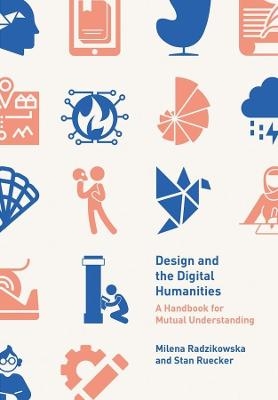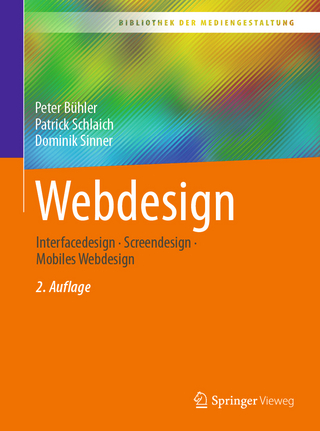
Design and the Digital Humanities
Intellect Books (Verlag)
978-1-78938-358-4 (ISBN)
This is an essential practical guide for academics, researchers and professionals involved in the digital humanities, as well as designers working with them. It prepares readers from both fields for working together, outlining disciplinary perspectives and lessons learned from more than twenty years of experience, with over two dozen practical exercises.
The central premise of the book is a timely one – that the twin disciplines of visual communication design and digital humanities (DH) are natural allies, with much to be gained for researchers, students and practitioners from both areas who are able to form alliances with those from the other side. The disciplines share a common fundamental belief in the extraordinary value of interdisciplinarity, which in this case means that the training, experience and inclinations from both fields naturally tend to coincide. The fields also share an interest in research that focuses on humanities questions and approaches, where the goal is to improve understanding through repeated observation and discussion. Both disciplines tend to be generative in nature, with the ultimate end in many cases of designing and creating the next generation of systems and tools, whether those be intended for dealing with information or communication.
The interdisciplinary nature of this book is both a strength and a challenge. For those academics and practitioners who have worked with the other discipline, this will be a much-welcomed handbook of terminology, methods and activities. It will also be of interest to those who have read about, seen presented and used the outcomes of successful design and DH collaborations, and who might be interested in forming similar partnerships.
However, for all they have in common, design and digital humanities also have significant differences. This book discusses these issues in the context of a variety of research projects as well as classroom activities that have been tried and tested. This book will provide both design and the digital humanities with a better mutual understanding, with the practical intention of working effectively together in ways that are productive and satisfying for everyone involved.
Design education has a long history, a presence in many post-secondary institutions, and a robust market for educational and practice-based literature. The Digital Humanities community, in contrast, is much younger, but rising rapidly, both academically and within industry. Both design and DH are collaborative disciplines, with much in common in terms of vision, but with confusing overlap in terminology and ways-to-practice.
The book describes and demonstrates foundational concepts from both fields with numerous examples, as well as projects, activities and further readings at the end of each chapter. It provides complete coverage of core design and DH principles, complete with illustrated case studies from cutting-edge interdisciplinary research projects. Design and the Digital Humanities offers a unique approach to mastering the fundamental processes, concepts, and techniques critical to both disciplines.
It will be of interest to those who have been following previous work by bestselling authors in the fields of visual communication design and the digital humanities, such as Ellen Lupton, Steven Heller, Julianne Nyhan, Claire Warwick and Melissa Terras.
This guide is suitable for use as an undergraduate or masters-level text, or as an in-the-field reference guide. Throughout the book, terms or concepts that may not be familiar to all readers are carefully spelled out with examples so that the text is as accessible as possible to non-technical readers from a range of disciplines.
Dr. Milena Radzikowska designs, teaches and conducts research as a feminist, committed mentor and community builder. Her work in human-computer interaction is reciprocally informed by her passion for creating safer, more inclusive and compelling spaces, both digital and analogue. Stan Ruecker is the Anthony J. Petullo Professor in Design at the University of Illinois. He is currently exploring physical interfaces for tasks such as analyzing text, modelling time and designing experience.
Introduction
Selling the Value of Design
The Epistemological Modes of Knowledge Production
Change is scary
i) Territory of Possible Engagements
ii) Moving the Goalposts
What expertise looks like
i) Who are Designers?
ii) Who are the Digital Humanists?
iii) What Expertise in Collaboration Looks Like
EXERCISES: Meaning
Creating understanding
Defining DH
i) What do Digital Humanists Do?
Defining design
i) Is There Such Thing As Good Design? If So, What Is It?
ii) Why Design Matters
iii) Critical Design
iv) What do Designers Do?
What is Publishable
Case study 1: how design students define themselves
EXERCISES: Form and text
Misunderstandings
Terms from DH
i) Text Encoding
ii) Structured Data
iii) Federated Data
iv) Linked Data: A Brief Historical Foray into the Memex
Terms from Design
i) Sketches
Types of sketches
ii) Three Forms of User-Centered Design
iii) Design Thinking
iv) Reframing
v) Gestalt
Claim Games
i) Research
ii) Projects and Research Projects
iii) Image
iv) Text
v) Prototypes
vi) Metaphors and Other Figures of Speech
vii) Iteration
Case study: what's a book?
EXERCISES: Collections and territories
Meeting points
Humanities visualization
i) Why Graphical Representation?
ii) Rich Prospect Browsing
iii) Proposing New RPB Principles and Tools
Principle of Participation
Principle of Association
Principle of Contexuality
Principle of Pluralism
iv) A Critical Challenge to the Power Embedded in Prospect and Refuge
Case studies: DH-based visualizations created by undergraduate design students
i) BigSee
ii) Structured Surfaces
iii) Results
iv) What We’d Change
Case studies: Decision Support Systems
i) Descriptive Reflections
ii) Design Z (Gears)
iii) Design A+1 (Bars & Sliders)
iv) Design B (Lines & Dots)
v) Analytical Reflection
vi) Feminist RPB in Manufacturing DSS
vii) Critical Reflection Using Feminist HCI
viii) Reflection Using a Critical Design Framework
EXERCISES: Data visualization and interface design
Working better together: interdisciplinary research in practice
Developing interdisciplinary researchers
i) Undergraduate Interdisciplinary Researchers
ii) Masters-Level Interdisciplinary Researchers
iii) PhD-Level Interdisciplinary Researchers
iv) Resource Needs
v) Critical Non-Tangibles
What is Respectable?
Project management for interdisciplinary researchers
i) Ways of Collaborating
ii) Delegation vs Collaboration
iii) Cross Disciplinary Lessons Learned
Managing people who are sensitive to their surroundings
i) Designers as Paramecium
Tenacity, or Sticking it Out
Repetition: Same Shit, Different Pile
Comparison: One Person’s Poison is Another Person’s Nutrient
Community: A World of Paramecia
Changing the World
From Bad to Worse: What if the Choice is Between Greater Poison and Lesser Poison?
From Good to Better: Choosing Among Nutrients
Discontinuity, or Sudden Death
Unanticipated Side-Effects
Reality Check: Taking a Few Roughs with a Smooth
Case study: Interdisciplinary research project charter
i) The Project Charter
ii) Most Recent Additions and Considerations
EXERCISES: Planning
Our Journey Continues
From the Digital to the Physical
Design for Peace and Reconciliation
Collaborative
Design Concepts Lab
Final thoughts
EXERCISES: Intellectual territories
| Erscheinungsdatum | 19.08.2021 |
|---|---|
| Zusatzinfo | 33 Charts; 46 Illustrations, black and white |
| Sprache | englisch |
| Maße | 170 x 244 mm |
| Themenwelt | Kunst / Musik / Theater ► Design / Innenarchitektur / Mode |
| Mathematik / Informatik ► Informatik ► Grafik / Design | |
| ISBN-10 | 1-78938-358-7 / 1789383587 |
| ISBN-13 | 978-1-78938-358-4 / 9781789383584 |
| Zustand | Neuware |
| Informationen gemäß Produktsicherheitsverordnung (GPSR) | |
| Haben Sie eine Frage zum Produkt? |
aus dem Bereich


